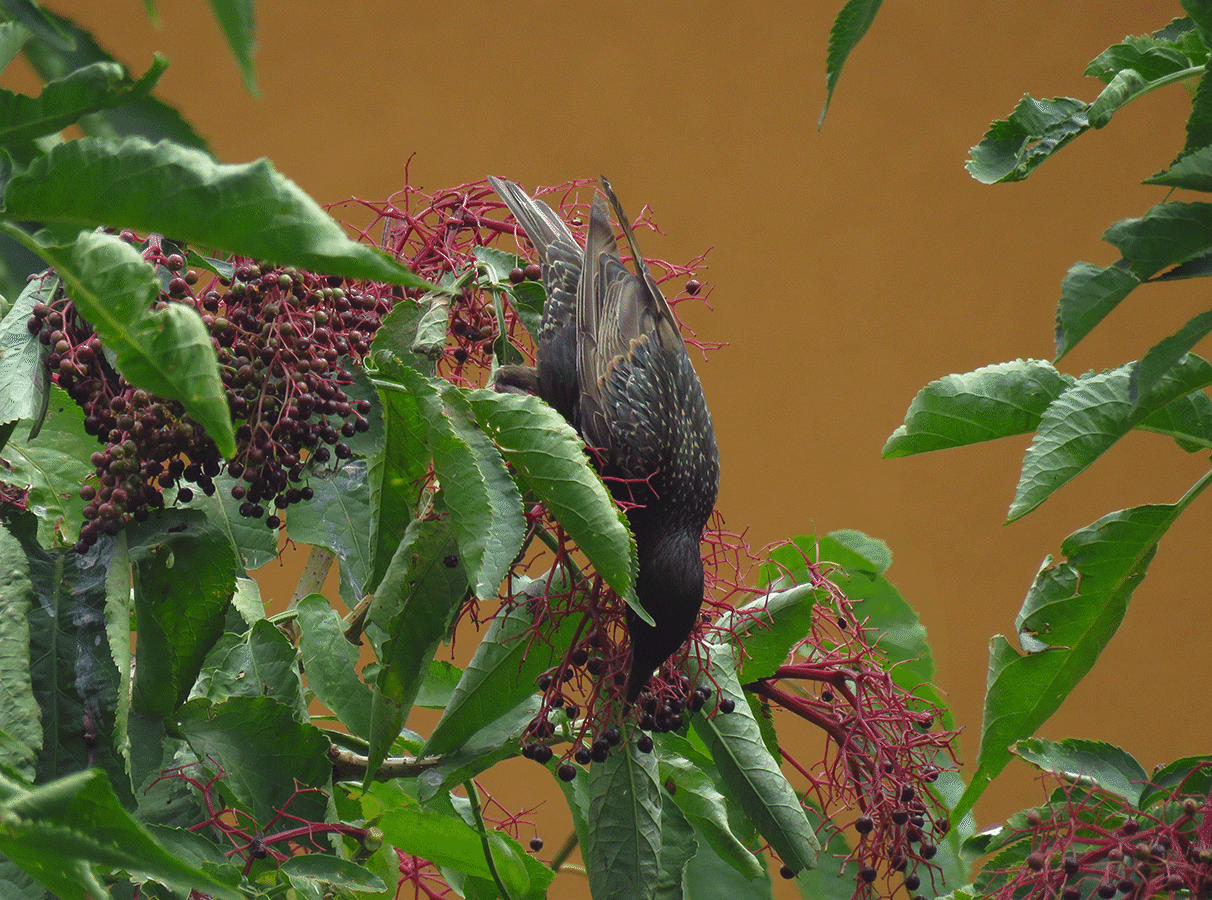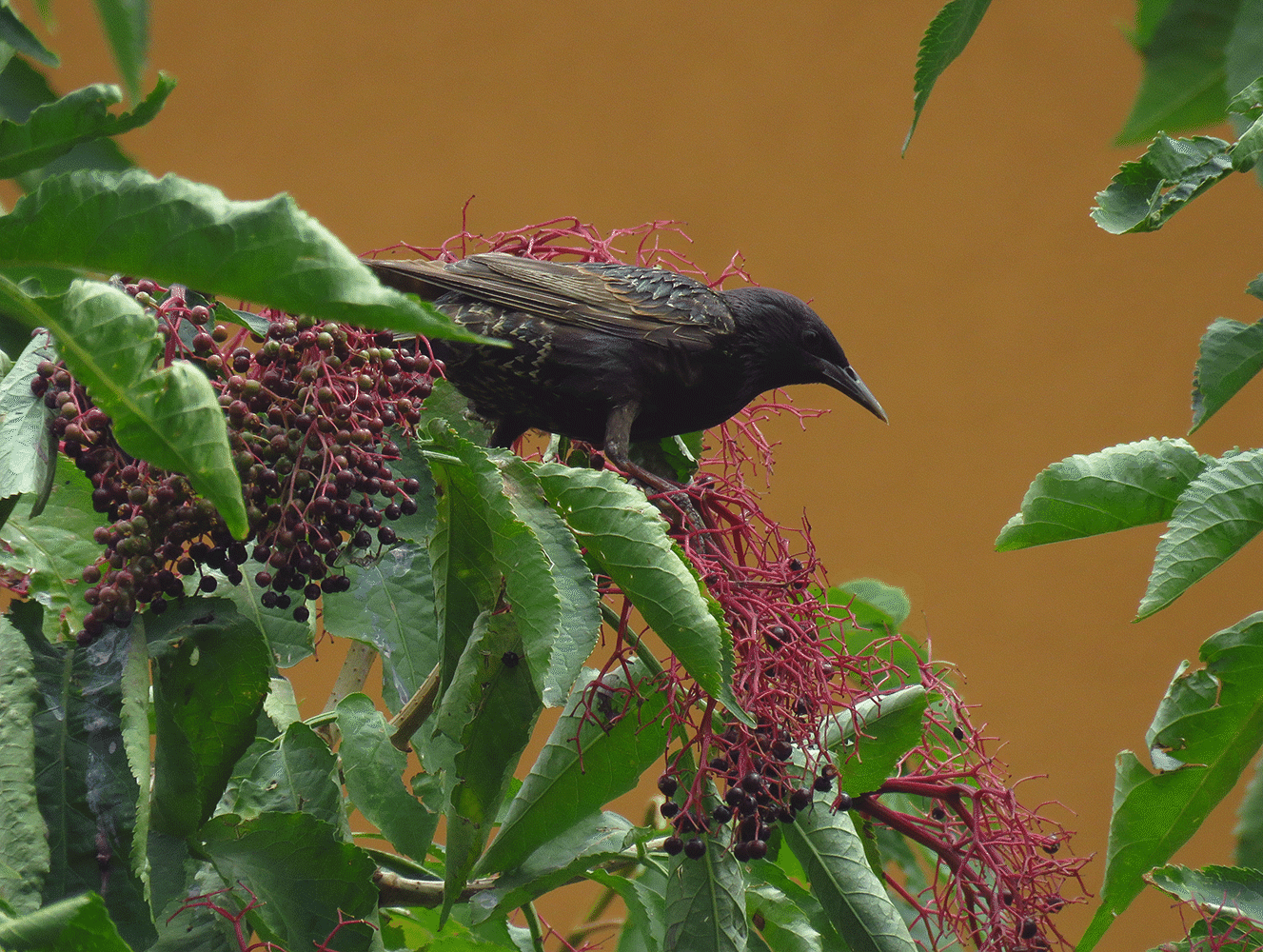After a period of abundant blooming in spring, the elderberry tree in my yard produces tons of juicy, dark berries in July. A few weeks ago, a small flock of starlings came to feed on them.

Most of the birds were juveniles. In this opening photograph, the focus is on a starling that is very close to adulthood. Its feathers are adorned with interesting colors and patterns. Slightly blurred in the foreground is a grayish-brownish juvenile with much duller plumage. In the following shot ...
... the more adult-looking bird is blurred in the background.
The protagonists of today's post are commonly known as the common or European starlings. The scientific name of the species is Sturnus vulgaris.
The breeding season for common starlings in the northern hemisphere is from April to July. In that period, besides some changes in the plumage, the bill of the adults becomes yellow. Since all the birds I photographed in the first weeks of July still have dark bills, I concluded that they are still immature, but who knows? I'm not an expert in this stuff, so there is a probability that I'm wrong.
The feathers of one of the birds shown in this set of six photographs have a nice, pronounced shine typical of adult birds. Only the dark bill doesn't fit the image of an adult starling.
This photograph provides a good idea of the abundance of fruits on the elderberry tree in my yard.
The starlings kept coming for four or five days, so I had plenty of time to observe them between my usual daily chores.
It took me a day or two to get them accustomed to my relatively close presence.
At first, the birds were eating only the berries they could reach while hidden behind the leaves. In this photograph, only part of the wing is peeking through the dense foliage.
Here you can see only the starling's head with a berry in its bill, while the rest of the bird is hidden behind the green curtain.
The real photographic fun started ...
... when starlings got out in the open.
This photograph shows an adult-looking bird with a berry nicely visible in its bill.
Here, you can see an animated GIF I created by combining 15 consecutive shots in Adobe Premiere Pro 2020.
If you take the time to explore all the details in this shot, especially if you enlarge the picture by clicking on it, you'll notice that the bird near the upper edge of the frame has a plumage around the base of the bill tinted in redish-purple.
At some point, I noticed that many starlings had that tint near the bill, and sometimes all over the head.
Some of them looked scratched or wounded at first sight, but that reddish thing wasn't blood but juice of the berries.

The birds were smudgy like young children after voraciously emptying a jar of jam or carelessly eating a big bluberry ice cream. In some photographs, the eye of the bird looks exactly like the elderberry fruit.
A week after the starlings left, my friend Denis, better known as @denisdenis here on Hive, picked a sack of elderberry fruits from the tree to create a delicious Jam that looked almost as good as it tasted. The above photograph was taken through the macro lens. You can see the tiny seeds that are usually hidden inside the fruits.
Here you can see the entire jar.
After removing the lid, I took another macro shot from above.
In this shot, the jam is served with high-fat cream.
This morning, about an hour ago, after my elderberry breakfast ...
... I was smudgy just like the birds in this post.
Starlings and many other birds can eat these berries raw.
People can't. I mean, they can, but the consequences are mildly unpleasant.
I tried these berries raw, and I ate a lot. It happened a long time ago when I didn't know anything about them. The fruits looked good and tasted sweet. That seemed like more than enough to know before getting into a feeding frenzy after smoking some weed. It wasn't a big deal. Just diarrhea and some weird feeling in the throat while breathing and swallowing.
Birds are crucial for the dispersal of elderberry seeds. The plant depends on them in that part of its reproductive cycle.
They consume the nutrients from the meat and juice of the berries, but the seeds exit the bird's digestive tract intact.
I photographed quite a few starlings in those four or five days in July.
The one shown here was singing when the photograph was taken.
Today, while exploring the internet in search of some facts about European starlings, I learned that they are very good at mimicking sounds. They can imitate the sounds of many different birds, but not only that. They can also do it with car alarms, music, and human speech. I didn't know that.
Common starlings are gregarious birds that can form enormous flocks. That's something I knew already, and I've seen some impressive flocks here in my area, but ...
... but I didn't know that, partially due to their social nature and totally due to their musical talent, they can be affectionate and extremely charming, intelligent pets when hand-raised by humans.
Wolfgang Amadeus Mozart kept a pet starling for about three years. It was a common European starling like the ones shown in the post. According to some sources, he taught the bird to sing at least one of his tunes.
Sturnus vulgaris is a mainly insectivorous species. Fruits are a nice sugary supplement, but insects and other small arthropods are necessary for a starling's healthy diet, especially when it comes to raising the offspring.
In these two shots, a starling is posing at the top of the cherry tree that grows very close to the elderberry. The cherry tree is a few meters taller.
And that's it.
I mean, the post isn't over yet, but ...
... but there isn't much left to say at this point.
The nice, uniformly orange background present in many of these photographs ...
... was provided by the house across the street.
From a certain angle, the orange facade created a color gradient effect.
I don't know much about the people who live there, but the house itself is a good neighbor.
As always here on Hive ...
... the photographs are my work. Good night.
The following links will take you to a few sites with more information about the protagonists of today's post. I found some stuff about them there.
https://en.wikipedia.org/wiki/Common_starling
https://en.wikipedia.org/wiki/Mozart%27s_starling
https://www.vermontpublic.org/programs/2019-02-25/timeline-mozarts-starling










































